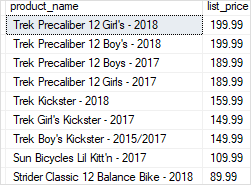Summary: in this tutorial, you will learn how to use the SQL Server ALL operator to compare a value with a list of single column set of values.
Overview of the SQL Server ALL operator
The SQL Server ALL operator is a logical operator that compares a scalar value with a single-column list of values returned by a subquery.
The following illustrates the ALL operator syntax:
scalar_expression comparison_operator ALL ( subquery)
Code language: SQL (Structured Query Language) (sql)In this syntax:
- The
scalar_expressionis any valid expression. - The
comparison_operatoris any valid comparison operator including equal (=), not equal (<>), greater than (>), greater than or equal (>=), less than (<), less than or equal (<=). - The
subquerywithin the parentheses is aSELECTstatement that returns a result of a single column. Also, the data type of the returned column must be the same data type as the data type of the scalar expression.
The ALL operator returns TRUE if all the pairs (scalar_expression, v) evaluates to TRUE; v is a value in the single-column result.
If one of the pairs (scalar_expression, v) returns FALSE, then the ALL operator returns FALSE.
SQL Server ALL operator examples
Consider the following products table from the sample database.

The following statement returns a list average list prices of products for each brand:
SELECT
AVG (list_price) avg_list_price
FROM
production.products
GROUP BY
brand_id
ORDER BY
avg_list_price;
Code language: SQL (Structured Query Language) (sql)
1) scalar_expression > ALL ( subquery )
The expression returns TRUE if the scalar_expression is greater than the largest value returned by the subquery.
For example, the following query finds the products whose list prices are bigger than the average list price of products of all brands:
SELECT
product_name,
list_price
FROM
production.products
WHERE
list_price > ALL (
SELECT
AVG (list_price) avg_list_price
FROM
production.products
GROUP BY
brand_id
)
ORDER BY
list_price;
Code language: SQL (Structured Query Language) (sql)
2) scalar_expression < ALL ( subquery )
The expression evaluates to TRUE if the scalar expression is smaller than the smallest value returned by the subquery.
The following example finds the products whose list price is less than the smallest price in the average price list by brand:
SELECT
product_name,
list_price
FROM
production.products
WHERE
list_price < ALL (
SELECT
AVG (list_price) avg_list_price
FROM
production.products
GROUP BY
brand_id
)
ORDER BY
list_price DESC;
Code language: SQL (Structured Query Language) (sql)
Similarly, you can take your own examples of using the ALL operator with one of the following comparison operators such as equal to (=), greater than or equal (>=), less than or equal to (<=), and not equal (<>).
In this tutorial, you have learned how to use the SQL Server ALL operator to compare a scalar value with a single column set of values returned by a subquery.